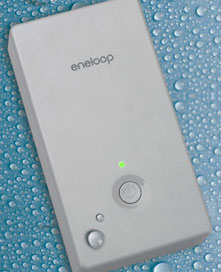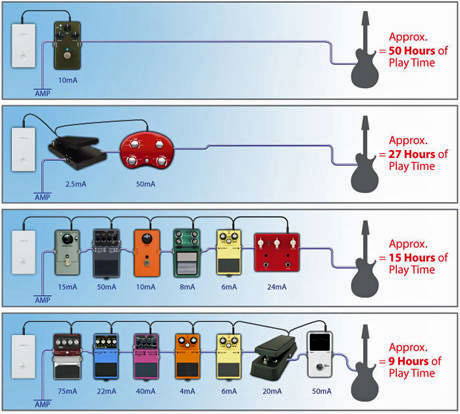Gig Test: Sanyo Pedal Juice, Pt 1
by John Drenning
How many of you went from being actual rocker to armchair rockers? I’m sure I’m not the only one…otherwise who’s buying all those Paul Reed Smiths?!
Played my first show at 17: Hondo Strat copy, Whirlwind coiled cord, Arion Metal Master pedal, and the ultimate sacrilege, silverface Fender Twin with Celestion SideWinders. My until-recently last show was at 22: mid-’70s goldtop Les Paul Deluxe, Yamaha wireless, Marshall JCM 800 full stack.
In between were more shows than I can count, and a couple records – yes actual records made out of petroleum products – and countless miles driven through the wilds of the Northeast to “Bring The Rock” to an unsuspecting populace.
Then at 23 I moved away, the band got a new guitarist, and that was pretty much that.
Until last month.
My Aussie friends Nic and Blair had been tasked with programming the music for the Australia Day celebration at Seattle Center, and they needed Australian rock. I’d jammed with Nic a few times, one of those jerks who compounds the indignity of being incredibly talented on any instrument you can name by also being a super nice guy. But we’d never played out together before.
Nic mentioned Aussie band after Aussie band to me, none of which made much of a dent on American listeners, until finally he got to AC/DC. I said, Let’s Rock…and the skies darkened….
We worked up an 8-song set, drawing mostly on Bon Scott-era material, stopping at Back In Black. I learned a lot of solos, Nic borrowed an Ampeg SVT, our drummer learned how not to play fills, our singer shopped for trampy clothing.
But since I’d gone from being an actual rocker with two guitars and one amp to an armchair rocker with 14 guitars, six amps and 347 pedals, I had some hard decisions to make. What kind of rig did I want to use to be both Angus and Malcolm?
Powerage
As a guest-blogger’s luck would have it, I’d received a Sanyo Pedal Juice power supply in the mail right around when all this was taking place.
The Pedal Juice is one of those things that’s so simple, you can’t believe it hasn’t been around for ages. Put simply, it’s a cross between an external pedal power supply, like a Dunlop DC Brick or a T-Rex fuel tank, and a couple of rechargeable 9-volt batteries.
It’s a pretty simple device. You get a while plastic rectangular box, about the size of a Boss pedal, along with a charger, a polarity conversion cable, and two single adapters for the two taps on the end of the unit.
Out of the box, the Pedal Juice can power two 9-volt pedals, with a claimed battery life of 50 hours for a single analog pedal. You can power more pedals with a daisy-chain-style adapter cord, aka a “parallel DC cord,” not included but available at your local music store for the cost of a pack of strings.
It won’t surprise you to learn that when you start adding pedals, battery life declines accordingly. Normal rules of physics still apply.
It’s a breeze to operate. The Pedal Juice has a single LED on top to indicate charging progress and power remaining. Once it’s charged up, you just unplug it from the power adapter, plug in your pedals, and commence to Rock. You can velcro it onto a pedalboard if you’ve got the space, or just put it on the floor if you’re going commando. (It’s probably too big to fit underneath most boards, where you’d stash the Dunlop or T-Rex power supplies.)
The Pedal Juice doesn’t have the firepower required for 12v or 18v pedals. But I tried it with my Boss Space Echo – which like all the Boss twin pedals is rated at 9 volts but draws 75mA, as opposed to 7-10mA for a regular analog pedal – and the Pedal Juice handled this just fine. (The 9v taps on my Furman board don’t.)
Clearly Sanyo isn’t aiming this at the guy with a gigantic pedalboard, weird power needs, or the ability to discern alkaline vs lithium vs whatever in his Fuzz Face.
If you’re not running a kajillion pedals, or you don’t like springing for new batteries all the time but don’t like the ground loop hum that can result from a single power supply, or you don’t want to worry about finding a place to plug in your remote power supply at the front of the stage, then you ought to think about the Power Juice. It’s a nice, simple design.
But can it handle the rigors of AC/DC?
– End of part 1 of 2 –
Category: Reviews, Sanyo, Stompboxes/FX
















I have one and am hooked. Esp. when there’s that hum from the wall or when I want to set up where I want to set up on the stage. It lasts for a bunch of gigs between charges and the lights on it change color, so I laway know where I’m at, powerwise. Mine’s been dropped, mines had beer spilled on it and it still works perfect.
I love mine. I use it every set up, no matter how big or small (anywhere from 3 to 16 pedals)
All my gear sounds like it should every time cause they are ‘drinking’ the Pedal Juice!
I have one too – it rocks. Sound is clean as a whistle – no grounding problems. :D
Thank you for reviewing Pedal Juice (full disclosure: I work for
Sanyo and know all about Pedal Juice)
Here’s a thought:
The amount of time that pedal juice lasts on a single charge depends on the power needs of the set up. It provides 2000mA of power, 1000 mA out of each out. To estimate how long your set up will run, all you’d need to do is look up the draw of your gear and do the math.
And here’s a thought on price:
Pappy’s 5th Fret Blog points out – “…an Energizer 9v is on sale at $3.76. That’s $11.28 to power your three pedals and if you gig once a week (or change them out once a week) to make sure the batteries are strong enough to get through a gig every week for a month, that’s about $56.40. You can see how quickly the cost adds up and how much this will save you in the long run. If you kept on going at it every week for a year, you will have spent $586.56 and even if you changed out your batteries once every TWO weeks in an effort to save yourself some money you’ll still be paying almost a hundred bucks more at $293.28.â€
Thanks again!
Deb from Sanyo